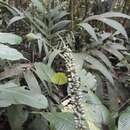pt-BR
nomes no trilho de navegação


Calyptrogyne ghiesbreghtiana is commonly known as the Coligallo Palm or Rooster Tail palm. It is an understory palm that can grow up to two meters tall. The plant requires almost full shading when young and partial shading when mature (Alvarez-Clare & Avalos, 2007). It has small white flowers pollinated by Phyllostomidae bats, but only a small percentage of the flowers visited initiate fruits. This leads to the idea that pollen availability may affect fruit initiation (Cunningham, 1995).
Grows in tropical forests on the Atlantic slope from Mexico through Belize, Guatemala, Honduras, Nicaragua, Costa Rica, and Panama. Is also found on the Pacific slope of Costa Rica. (Henderson et al., 1995).
Calyptrogyne ghiesbreghtiana has a short subterranean stem. The leaves are pinnate, producing 3-9 leaflets that are irregularly divided. The inflorescences are elongated and spicate. There is a penduncular bract that occurs at the top of the peduncle that falls just before flowering leaving a circular scar near the peduncle (Henderson et al., 1995). The flowers are small and white with a musky garlic smell. The flowers are monoecious and the male and female flowers open at different times. Flowers and fruits are produced year round, but no more than one inflorescence is active at a time (Cunningham, 2000). The fruits are small, one seeded, and egg shaped. They range from 1-2 cm long. The fruits start out black and turn bright red when ripe. The fruit mesocarp is fleshy with a net of wide fibers (Henderson et al., 1995).
Pollination
The flowers are pollinated at night by many different bat species. Various types of bats visit the flowers with one of two intentions. Frugivore bats from the sub families Stenodermatinae and Carolliinae visit the flowers to indulge on the inflorescences while perched. Glossophaginae consists of nectivore bats that extract nectar from a hovering position. It is suggested that Calyptrogyne ghiesbreghtiana has evolved to utilize these two vectors of pollination in combinations, because evidence has shown that the number of mature fruits was significantly lower in the plants that were solely exposed to hovering pollinators (Tschapka, 2003). Since bats can fly for relatively long distances compared to insect pollinators such as bees, the pollen can be dispersed along a wide range. The plant wants to achieve as much distribution as possible while avoiding inbreeding. To avoid self-pollination, the male and female flowers are temporally separated. Male flowers open for five nights. The next three nights consist of no flowers opening, and during the subsequent two nights, female flowers open (Cunningham, 2000).
Flower Predation
In any mutualistic relationship, both organisms are constantly evolving to benefit the most from the relationship while contributing the least amount of energy possible. In order for the flowers to attract pollinators, they must sacrifice some form of energy to make the plant attractive to Phyllostomidae bats (Cunningham, 1995). Usually this is done in the form of nectar, but in the case of Calyptrogyne ghiesbreghtiana, it offers the consumption of its own flowers to the bats. The bats mostly consume the fleshy filament in the center of the male flowers and the staminoid of the female flowers. The Coligallo Palm makes this sacrifice in order to successfully reproduce (Cunningham, 1997).
Seed Predation
A major problem for Calyptrogyne ghiesbreghtiana is the predation of seeds with no reciprocity. When the Phyllostomidae bats eat the flowers, they aid the plant through pollination. However, when the seeds and flowers are simply predated by katydids and Scarab Beetles, there is no benefit to the plant. Katydids damage more flowers on the taller inflorescences of the plants, which tends to repel potential pollinating bats. The amount of bat visitation is negatively correlated with the amount of katydid damage, meaning as the inflorescences are increasingly consumed by katydids, the less likely they are to be pollinated. It is logical that this may lead to an evolutionary mechanism of defense against such insects, but it is incredibly difficult to have a defense from insect herbivory without repelling the bats as well (Tschapka, 2003). Calyptrogyne ghiesbreghtiana lose up to 60% of their seeds to seed predation. Also, the plants never abort half eaten seeds; however, the ecological drive behind this conservation of destroyed seeds is unknown (Cunningham, 1996).
Phoretic Mites
Mites are also involved in the mutualistic relationship between Calyptrogyne ghiesbreghtiana and Phyllostomidae. Mites thrive when they are mobile and dispersed to reproduce at a wide variety of flower locations. To travel, they rely on phoresy, a passive form of transport in which they hitch a ride on animals that visit the flowers (Tschapka & Cunningham, 2004). There have been many documented cases of phoretic mites traveling on insects such as bees, butterflies, and beetles (Boggs & Gilbert 1987; Ochoa, et al., 1995; Walter, et al., 1998). However, there is a lack of experimentation conducted on phoretic mites being transported by mammals. Tschapka and Cunningham, 2004 conducted an experiment that analyzed the mite colonization on Calyptrogyne ghiesbreghtiana inflorescences. They also found the same mites on the Phyllostomidae bats that were captured. They also noticed that there were more phoretic mites on the bats that they observed to regularly visit the inflorescences and feed on the fleshy flower parts or fruits.
Found in very wet understories in lowland to montane rain forest, from sea level to 1500m. Plants from higher elevations tend to have narrower leaflets (Gargiullo et al., 2008).
Phyllostomidae bats are the main dispersers. The bats pick the fruits and fly back to their roost where they consume the fleshy mesocarp and discard the seed. The seed then falls to the ground below to begin germination. Bat dispersion is very beneficial to the plant because bats can fly relatively far distances and greatly increase the plant’s distribution (Cunningham, 1995).
empty